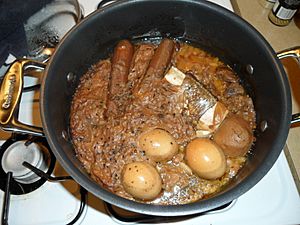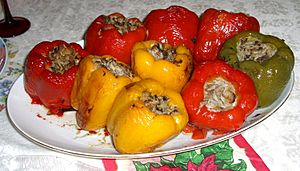Sephardic Jewish cuisine facts for kids

Sephardic Jewish cuisine is a collection of cooking traditions. These traditions were created by the Sephardi Jews. These are Jewish people whose families originally came from the Iberian Peninsula (modern-day Spain and Portugal).
After being forced to leave their homes, many Sephardic Jews settled around the Mediterranean Sea. They went to places like Turkey, Greece, the Balkans, and countries in West Asia and North Africa. These groups are known as the Eastern Sephardim and North African Sephardim. Other Sephardic Jews, called the Western Sephardim, settled in places like Holland and England. Their cooking styles also became part of Sephardic cuisine.
Sometimes, Mizrahi Jews (who are Jewish people from the Middle East, not Spain or Portugal) are also called Sephardim. This is because their religious services are similar. However, this article focuses only on the food of Jewish people whose families came from the Iberian Peninsula, no matter where they settled.
Just like other Jewish groups around the world, Sephardic Jews cooked foods popular in their new homes. But they always made sure to follow Jewish dietary laws, called kashrut. This means their food is kosher. They also used ingredients that were easy to find and not too expensive.
For example, meat had to be prepared in a special way called shechita, which is Jewish ritual slaughter. After slaughter, meat is soaked and salted to remove blood. Because of this, meat was often saved for holidays and special events. Many Sephardic dishes use ground meat. Also, milk and meat products could never be mixed or eaten at the same meal.
Vegetables that are cooked, stuffed, or baked are very important in this cuisine. So are different kinds of beans, chickpeas, lentils, and bulgur (cracked wheat). Rice is often used instead of potatoes.
Contents
A Taste of History: Sephardic Food Journeys
Sephardic Jews are the Jewish people who lived in Spain. In 1492, they were forced to leave Spain or become Christian. Many of them moved to North African countries like Morocco, Tunisia, Algeria, and Libya. They became the North African Sephardim. Others settled in Greece, Turkey, Syria, and the Holy Land. These became the Eastern Sephardim.
The Western Sephardim, also known as Spanish and Portuguese Jews, left Spain and Portugal over the next few centuries. They had often pretended to be Christian but returned to Judaism once they reached places like Holland and England.
While the Jewish people already living in these new countries (like the Mizrahi Jews in the Middle East) had their own foods, "Sephardic cuisine" usually means the cooking traditions of those with family roots in Spain and Portugal.
Both the Jews from Spain and Portugal, and the Jewish communities already living in places like Morocco, Tunisia, Algeria, and Turkey, changed local dishes to fit kosher rules.
Today, with Jewish people from all over the world living in Israel, these different local cuisines have come together. They now represent what is broadly known as Sephardic cuisine.
Some Sephardic Jews who fled the Inquisition in the 1400s settled in Recife, Brazil. Their cooking was influenced by new local foods like molasses, rum, sugar, vanilla, chocolate, and different vegetables such as bell peppers, corn, and tomatoes. They also started using turkey.
In 1654, 23 Sephardic Jews arrived in New Amsterdam (which is now New York City). They brought their unique cuisine to the early United States. Many early American Jewish recipes were influenced by this branch of Sephardic cooking. These recipes often followed traditional holidays. They included dishes like stew, fish fried in olive oil, beef and bean stews, and egg custards. The first kosher cookbook in America, The Jewish Cookery Book by Esther Levy, was published in 1871. It contained many of these traditional recipes.
Sephardic Cuisine: The Basics
Sephardic cooking often features fresh salads, stuffed vegetables, and vine leaves. Olive oil, lentils, fresh and dried fruits, herbs, nuts, and chickpeas are also very important. Meat dishes often use lamb or ground beef.
Fresh lemon juice is added to many soups and sauces. Many meat and rice dishes include dried fruits like apricots, prunes, and raisins. Pine nuts are often used as a garnish on top of dishes.
Herbs and Spices: Flavors from Afar
In the past, Sephardic food was shaped by the local cooking of Spain and Portugal. This was true both when Catholics and Muslims ruled these lands. When Muslims were in charge, new and exciting foods from other countries became popular. You can still see these ingredients in the cuisine today.
Spices like Cumin, cilantro, and turmeric are very common in Sephardic cooking. Caraway and capers were brought to Spain by Muslims and are used in many dishes. Cardamom is used to flavor coffee. Fresh cilantro and parsley are often chopped and used as a garnish. Chopped mint is added to salads and cooked meals, and fresh mint leaves are served in tea. Cinnamon is sometimes used to season meat, especially in dishes made with ground meat. Saffron, which grows in Spain, is used in many types of Sephardic cooking, as are other spices found where they settled.
Sweet Treats and Drinks

Small cups of Turkish coffee, sometimes with a hint of cardamom, are often served after a big meal. They come with small pieces of baklava or other pastries dipped in sweet syrup or honey. Hot sahlab, a creamy cornstarch pudding, is a popular winter drink. It's often topped with cinnamon, nuts, coconut, and raisins. Arak is a favorite alcoholic drink. Rose water is a common ingredient in cakes and desserts. Malabi, a cold cornstarch pudding, is often drizzled with rose water and red syrup.
Pickles and Sauces: Zesty Sides
Olives and pickled vegetables like cucumbers, carrots, cabbage, and cauliflower are always served with meals. Amba is a tangy pickled mango sauce. Small pickled lemons are a special treat from Tunisia and Morocco.
Shabbat and Holiday Meals
Shabbat: A Day of Rest and Delicious Food
On Shabbat (the Jewish day of rest), Jews in North Africa (Tunisia and Morocco) often eat chreime, which is fish in a spicy tomato sauce.
Since cooking is not allowed on Shabbat, Sephardic Jews, like other Jewish groups, created slow-cooked dishes. These foods would simmer on a low heat overnight and be ready to eat the next day.
One such slow-cooked dish was ropa vieja. Its oldest name is chamin (from the Hebrew word "cham," meaning "hot"). When Sephardic Jews were expelled from Spain in 1492, many went to North Africa. There, the hamin changed to fit local ingredients and was called dafina in Morocco. You can add any favorite vegetables to it, and the eggs can be taken out and eaten at any time. The Ashkenazi (another Jewish group) version of this dish is called cholent.
Shavfka is another Sephardic dish that has a similar Ashkenazi dish called kugel. Bourekas (savory pastries) are often served on Shabbat morning. Pestelas, which are pastries topped with sesame seeds and filled with pine nuts, meat, and onion, are also traditional.
Sambusak is a half-moon-shaped dough pocket filled with mashed chickpeas, fried onions, and spices. It has been a traditional part of the Sephardic Shabbat meal since the 1200s.
Passover: A Time for Freedom and Special Foods

Sephardic and Ashkenazi cooking is quite different during Passover. This is because Sephardic Jews are allowed to eat kitniyot (like rice, corn, and beans), which Ashkenazi Jews traditionally avoid. Sephardic Jews make charoset, a symbolic food for the Passover seder, with different ingredients. While Ashkenazi charoset is usually chopped apples and nuts with wine and cinnamon, Sephardic charoset is often made from raisins or dates and is much thicker.
Mina (also called scacchi in Italy) is a Passover pie made with a matzo crust. It can be filled with meat or vegetables.
Rosh Hashana: Sweet Beginnings for a New Year

At the start of the evening meals for Rosh Hashanah (the Jewish New Year), it's a tradition to eat foods that symbolize a good year. A short prayer is said over each food. These foods are known as yehi ratsones.
Typical foods, often served on a large platter, include:
- Apples dipped in honey, or baked, or in a compote called mansanada.
- Dates.
- Pomegranates, or black-eyed peas.
- Pumpkin, often in savory pastries called rodanchas.
- Leeks, made into fritters called keftedes de prasa.
- Beets, usually peeled and baked.
- The head of a fish, often part of a fish dish with the whole fish.
It's also common to eat stuffed foods on Rosh Hashana, like a stuffed, roasted bird or various stuffed vegetables called legumbres yaprakes. This symbolizes a year full of blessings.
Yom Kippur: Breaking the Fast
The first food eaten after the Yom Kippur fast can be different depending on where you are from. Iranian Jews often eat a mix of shredded apples and rose water called faloodeh seeb. Syrian and Iraqi Jews eat round sesame crackers that look like small bagels. Turkish and Greek Jews sip a sweet drink made from melon seeds.
Hanukkah: Festival of Lights and Fried Delights
For Hanukkah, Sephardic dishes include cassola (sweet cheese pancakes), buñuelos (puffed fritters with an orange glaze), keftes de espinaka (spinach patties), keftes de prasa (leek patties), and shamlias (fried pastry frills).
Other Special Sephardic Dishes

- Almadrote—a sauce made with oil, garlic, and cheese, often served with eggplant casserole.
- Baba ghanoush—mashed cooked eggplant mixed with olive oil, lemon juice, seasonings, and sometimes tahini.
- Baklava—a layered dessert with thin filo pastry, chopped nuts, and sweet syrup or honey.
- Börekitas—small borekas filled with eggplant, spinach, or cheese.
- Couscous—tiny steamed balls of crushed durum wheat semolina, usually served with stew on top.
- Falafel—deep-fried balls or patties made from ground chickpeas or fava beans.
- Fazuelos—fried dough shaped into a spiral.
- Ful—a stew of cooked fava beans, served with oil, cumin, and sometimes parsley, garlic, onion, or lemon juice.
- Haminados—hard-boiled eggs cooked slowly for many hours until they turn brown.
- Halvah—a sweet candy made from sesame paste.
- Holishkes—blanched cabbage leaves wrapped around minced meat and cooked in tomato sauce.
- Hummus—a Middle Eastern dip or spread made from mashed chickpeas, tahini, lemon juice, and garlic.
- Kibbeh—dishes usually made by pounding bulgur wheat with meat into a paste, then forming balls with pine nuts and spices.
- Kubbana—a traditional Yemenite Jewish bread, similar to monkey bread.
- Lahoh—a spongy, pancake-like bread from Yemen.
- Ma'amoul—shortbread pastries filled with dates or nuts.
- Malabi—a milk pudding made with rice, sugar, rice flour, and milk.
- Matbucha—cooked tomatoes and roasted bell peppers seasoned with garlic and chili pepper.
- Moroccan cigars—ground beef wrapped in dough and fried.
- Moussaka—a dish often made with layers of eggplant or potato, and sometimes ground meat.
- Pastel di carne con masa fina—a meat pie with a thin crust.
- Pescado frito—a traditional fried fish dish (often cod) for Shabbat, popular among 16th-century Andalusian Jews.
- Sabich—a sandwich in pita bread filled with fried eggplant, hard-boiled eggs, salat katzutz (chopped salad), parsley, amba, and tahini.
- Sahlab—a hot, thick milk-based winter drink, sometimes with orchid powder (now often artificial flavor), topped with nuts and cinnamon.
- Shakshuka—eggs poached in a sauce of tomatoes, olive oil, peppers, onion, and garlic, often spiced with cumin and paprika.
- Skhug—a spicy hot sauce from Yemen.
- Sofrito—a meat stew (lamb, beef, or chicken) sautéed with potatoes, garlic, turmeric, and cardamom.
- Tabbouleh—a vegetarian salad made mostly of finely chopped parsley, with tomatoes, mint, onion, bulgur, olive oil, lemon juice, salt, and sweet pepper.
- Tagine—a slow-cooked savory stew, usually made with sliced meat, poultry, or fish, along with vegetables or fruit.
- Tunisian mulukhiyah—a thick beef stew.
- Yaprah—stuffed grape leaves.
 In Spanish: Gastronomía sefardí para niños
In Spanish: Gastronomía sefardí para niños








